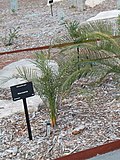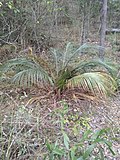| Burrawang | |
|---|---|

| |
| Macrozamia communis | |
| Scientific classification | |
| Kingdom: | Plantae |
| Clade: | Tracheophytes |
| Clade: | Gymnospermae |
| Division: | Cycadophyta |
| Class: | Cycadopsida |
| Order: | Cycadales |
| Family: | Zamiaceae |
| Subfamily: | Encephalartoideae |
| Tribe: | Encephalarteae |
| Subtribe: | Macrozamiinae |
| Genus: | Macrozamia Miq. |
| Type species | |
| Macrozamia spiralis (Salisbury) Miquel
| |
Macrozamia is a genus of around forty species of cycads, family Zamiaceae, all of which are endemic to Australia. Many parts of the plant have been utilised for food and material, most of which is toxic if not processed correctly.
Description[edit]
A genus of cycads with partially submerged bole or tree, small to medium height, bearing a crown of palm-like fronds. The dioecious plants bear large cones, becoming even larger when ripening on the female, containing reproductive parts of great size.
Distribution[edit]
The greatest diversity of species occurs in eastern Australia, in southeast Queensland and New South Wales, with one species in the Macdonnell Ranges of Northern Territory and three in the southwest region of Australia.[1][2]
Taxonomy[edit]


The first description of the genus was published in 1842 by Friedrich Anton Wilhelm Miquel in his Monographia Cycadearum, without designating a type.[3]
The common name "burrawang",[4] originally referring to M. communis in the Daruk Australian Aboriginal language,[citation needed] is often used for all the species in the genus. Informal names published in state listing for the genus include 'rickets' (Bailey, 1931) in Queensland, a name also used in Western Australia for the symptoms of ingestion of species by cattle, and terms zamia, zamia palm, burrawang palm (Ross, 1989) and djeeri (Hopper, 2014) continued to be noted by New South Wales, QLD and W.A. authors in specific and generic usages.[5][6]
Species[edit]
| Phylogeny of Macrozamia[7][8] | |||||||||||||||||||||||||||||||||||||||||||||||||||||||||
|
| Image | Scientific name | Distribution |
|---|---|---|
| Macrozamia cardiacensis | southeast Queensland | |
 |
Macrozamia communis | east coast of New South Wales |
| Macrozamia concinna | New South Wales | |
| Macrozamia conferta | southeast Queensland | |
| Macrozamia cranei | southeast Queensland | |
| Macrozamia crassifolia | southeast Queensland | |
| Macrozamia denisonii | southeast Queensland | |
| Macrozamia diplomera | New South Wales | |
| Macrozamia douglasii | southeast Queensland | |
 |
Macrozamia dyeri | southern coast of Western Australia |
| Macrozamia elegans | New South Wales | |
 |
Macrozamia fawcettii | New South Wales |
| Macrozamia fearnsidei | southeast Queensland | |
| Macrozamia flexuosa | New South Wales | |
 |
Macrozamia fraseri | southwestern Western Australia |
| Macrozamia glaucophylla | New South Wales | |
| Macrozamia heteromera | New South Wales | |
| Macrozamia humilis | New South Wales | |
 |
Macrozamia johnsonii | New South Wales |
| Macrozamia lomandroides | southeast Queensland | |
| Macrozamia longispina | southeast Queensland | |
 |
Macrozamia lucida | southeast Queensland |
 |
Macrozamia macdonnellii | Macdonnell Ranges, Northern Territory |
| Macrozamia machinii | Queensland | |
| Macrozamia macleayi | Queensland | |
 |
Macrozamia miquelii | southeast and central Queensland |
| Macrozamia montana | New South Wales | |
 |
Macrozamia moorei | southeast and central Queensland |
 |
Macrozamia mountperriensis | southeast Queensland |
| Macrozamia occidua | southeast Queensland | |
| Macrozamia parcifolia | southeast Queensland | |
| Macrozamia pauli-guilielmi | southeast Queensland, northeast New South Wales | |
| Macrozamia platyrhachis | southeast Queensland | |
| Macrozamia plurinervia | southeast Queensland, northeast New South Wales | |
| Macrozamia polymorpha | New South Wales | |
| Macrozamia reducta | New South Wales | |
 |
Macrozamia riedlei | southwestern Western Australia |
 |
Macrozamia secunda | New South Wales |
| Macrozamia serpentina | southeast Queensland | |
 |
Macrozamia spiralis | New South Wales |
| Macrozamia stenomera | New South Wales | |
| Macrozamia viridis | southeast Queensland |
References[edit]
- ^ Kew World Checklist of Selected Plant Families
- ^ Orchard, A.E. & McCarthy, P.M. (eds.) (1998). Flora of Australia 48: 1-766. Australian Government Publishing Service, Canberra.
- ^ "Macrozamia Miq". Australian Plant Name Index (APNI), IBIS database. Centre for Plant Biodiversity Research, Australian Government.
- ^ APNI, citing Johnson, L.A.S. (1961), Zamiaceae. Flora of New South Wales 1: 23-41
- ^ Hopper, S.; Lambers, H. (2014), "9. Human relationships with and use of Kwongan plants and lands", in Lambers, Hans (ed.), Plant life on the sandplains in southwest Australia : a global biodiversity hotspot : kwongan matters, Crawley, Western Australia UWA Publishing, pp. 287–90, ISBN 978-1-74258-564-2
- ^ APNI cite: Bailey, F.M. (1913), Comprehensive Catalogue of Queensland Plants: 513
- ^ Stull, Gregory W.; Qu, Xiao-Jian; Parins-Fukuchi, Caroline; Yang, Ying-Ying; Yang, Jun-Bo; Yang, Zhi-Yun; Hu, Yi; Ma, Hong; Soltis, Pamela S.; Soltis, Douglas E.; Li, De-Zhu; Smith, Stephen A.; Yi, Ting-Shuang; et al. (2021). "Gene duplications and phylogenomic conflict underlie major pulses of phenotypic evolution in gymnosperms". Nature Plants. 7 (8): 1015–1025. bioRxiv 10.1101/2021.03.13.435279. doi:10.1038/s41477-021-00964-4. PMID 34282286. S2CID 232282918.
- ^ Stull, Gregory W.; et al. (2021). "main.dated.supermatrix.tree.T9.tre". Figshare. doi:10.6084/m9.figshare.14547354.v1.
{{cite journal}}: Cite journal requires|journal=(help)
- Johnson, L.A.S. (29 July 1959). "The Families of Cycads and the Zamiaceae of Australia". Proceedings of the Linnean Society of New South Wales. 84 (389): 64–117.
- "Macrozamia". FloraBase. Western Australian Government Department of Biodiversity, Conservation and Attractions.
External links[edit]
 Media related to Macrozamia at Wikimedia Commons
Media related to Macrozamia at Wikimedia Commons Data related to Macrozamia at Wikispecies
Data related to Macrozamia at Wikispecies- Hill, Ken. "Macrozamia". The Cycad Pages. Royal Botanic Gardens Sydney. Archived from the original on 2005-08-27.
- "About Macrozamia communis". Farrer Centre, Charles Sturt University. Archived from the original on 1999-10-12.
- "Primitive plants have hot, stinky sex". Reuters. 4 October 2007.
- "Macrozamia Miq". Atlas of Living Australia.